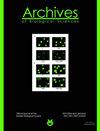Freshwater cyanobacteria in waters intended for human consumption in Serbia: Two decades of changes in diversity
IF 0.8
4区 生物学
Q4 BIOLOGY
引用次数: 2
Abstract
Herein we provide an assessment of cyanobacterial diversity and habitat preferences of potentially toxic and alien taxa, which could be an important tool for human health risk assessment regarding recreational and water-supply waterbodies. The diversity changes of cyanobacteria in waters intended for human consumption in Serbia were analyzed two decades after the first floristic study was published. The examination included phytoplankton and phytobenthic sample analysis from 35 localities in the period between 2012 and 2017, together with published literature records. The results indicate that the number of identified taxa doubled since the first Serbian Flora of Cyanobacteria was released two decades ago. The changes most likely occurred due to environmental factors, including hydrological transformations of habitats, cultural eutrophication and global warming. Many frequently recorded taxa are potentially toxic and bloom-forming. The spread of alien species with potentially invasive characteristics has also been noted. Canonical correspondence analysis (CCA) indicates that shallow waterbodies are the most vulnerable regarding the occurrence and expansion of bloom-forming, potentially toxic and invasive taxa. This shows the urgent need for a more detailed investigation. Additionally, although most of the research was focused on planktonic forms, benthic cyanobacteria represent an important component for public health risk assessment and therefore should be more frequently investigated.塞尔维亚供人类食用的淡水蓝藻:多样性的二十年变化
在此,我们提供了潜在有毒和外来分类群的蓝藻多样性和栖息地偏好的评估,这可能是一个重要的工具,人类健康风险评估在娱乐和供水水体。在第一份植物区系研究发表二十年后,对塞尔维亚供人类食用的水中蓝藻的多样性变化进行了分析。研究包括2012年至2017年期间35个地点的浮游植物和底栖植物样本分析,以及已发表的文献记录。结果表明,自20年前首次发布塞尔维亚蓝藻菌群以来,已鉴定的分类群数量翻了一番。这些变化最有可能是由环境因素引起的,包括生境的水文变化、文化富营养化和全球变暖。许多经常记录的分类群是潜在的有毒和开花形成。具有潜在入侵特征的外来物种的传播也已被注意到。典型对应分析(Canonical correspondence analysis, CCA)表明,浅水水体最容易发生和扩展形成水华的潜在毒性和入侵类群。这表明迫切需要进行更详细的调查。此外,虽然大多数研究的重点是浮游形式,但底栖蓝藻是公共健康风险评估的重要组成部分,因此应更频繁地进行调查。
本文章由计算机程序翻译,如有差异,请以英文原文为准。
求助全文
约1分钟内获得全文
求助全文
来源期刊
CiteScore
1.40
自引率
0.00%
发文量
25
审稿时长
3-8 weeks
期刊介绍:
The Archives of Biological Sciences is a multidisciplinary journal that covers original research in a wide range of subjects in life science, including biology, ecology, human biology and biomedical research.
The Archives of Biological Sciences features articles in genetics, botany and zoology (including higher and lower terrestrial and aquatic plants and animals, prokaryote biology, algology, mycology, entomology, etc.); biological systematics; evolution; biochemistry, molecular and cell biology, including all aspects of normal cell functioning, from embryonic to differentiated tissues and in different pathological states; physiology, including chronobiology, thermal biology, cryobiology; radiobiology; neurobiology; immunology, including human immunology; human biology, including the biological basis of specific human pathologies and disease management.

 求助内容:
求助内容: 应助结果提醒方式:
应助结果提醒方式:


